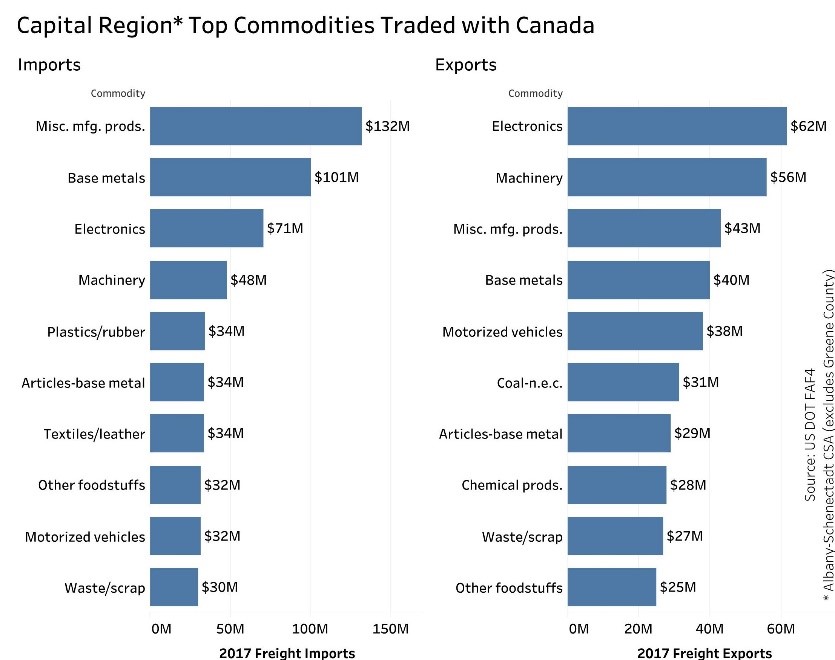The Capital Region’s North American Trade Partners
If Canada ratifies the United States-Mexico-Canada Agreement (USMCA) as expected, it could help the Capital Region1 boost trade with its northern neighbor. With the USMCA promising to provide U.S. producers of automotive parts and dairy and poultry products with new market access to Canada– and motorized vehicles and agricultural foodstuffs being the region’s top five and 10 exports to that country – the eight counties could soon be sending more of those commodities northward.
Imports and Exports
In 2017, the most recent year for which data is available, $578.5 million in freight originating from the Capital Region was exported by all modes (e.g., truck, rail, air, water) to Canada, while $849.3 million of freight originating from Canada was imported into the region. More than two thirds of these Canadian exports were shipped via truck from the region. This data reflects freight that began its journey from a particular location and does not necessarily mean the shipped commodities were made in them.

During the same year, $213.4 million in freight originating from the region by all modes was exported to Mexico, while $182.3 million in freight originating from that country was imported into the region.
Commodities
The top commodities exported from the Capital Region to both Canada and Mexico were, to varying extents, electronics, machinery, miscellaneous manufactured products and base metals. These items also ranked among the top commodities imported into the region from Canada, while the top Mexican imports were machinery, electronics, precision instruments and miscellaneous manufactured products. Other exports with strong manufacturing bases in the region included plastics/rubber and chemical products.


USMCA
The United States and Mexico have already ratified the pact. Under the deal, Canada would expand market access for American food and agricultural products, including chickens, eggs, fluid milk, cream, butter, skim milk powder, cheese, and other dairy products. Tariffs will also be eliminated on whey and margarine. Washington County is New York’s 10th biggest producer of milk by sales and Saratoga County is the 20th. Greene County is the state’s eighth largest producer of poultry and eggs and Saratoga County is the 11th. In 2017, the region exported $25 million in agricultural foodstuffs to Canada and $2.8 million to Mexico.
The USMCA also promises to increase Canadian and Mexican purchases of U.S.-produced auto parts, with new auto parts purchases estimated to reach $23 billion annually within five years. In 2017, Capital Region motorized vehicle exports, a category that includes automobiles and parts, totaled $38 million to Canada and $5 million to Mexico.
CEG Activities
To boost Capital Region exports, CEG is engaged in the following activities:
Industry Attraction: CEG travels the world to market the Capital Region’s tech assets and talent, including to places such as Ireland, Canada, Saudi Arabia and Germany.
Exportech: A CEG Business Growth Solutions (BGS) program that provides manufacturers with a step-by-step system for expanding into new markets, adding customers and driving profitable growth.
Global NY: This is the state’s one-stop shopping center for New York businesses looking to enter foreign markets, providing them with loan and grant opportunities, export marketing assistance services and State Trade Expansion Program (SET) funding.
Notes
1 Capital Region = Albany-Schenectady Combined Statistical Area (excludes Greene County).
2 Source: US DOT Freight Analysis Framework/CEG.
All CEG members have access to BGS services, which include programming for lean enterprises systems, technology acceleration, quality improvement, cost reduction, new market expansion, management strategy and sales growth. To schedule a consultation with CEG BGS Director Michael Lobsinger email michaell@ceg.org or call 518-465-8975 X238.
Don’t miss these insights into the trends that are shaping the Capital Region’s economy. Sign up for CEG’s e-news and follow us on:













